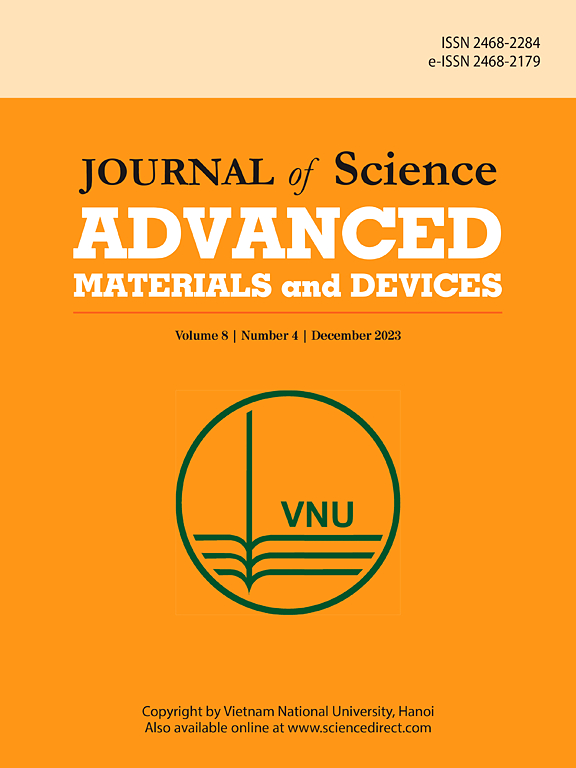Developing G-T-B glass system doped holmium oxide for radiation absorption and optical applications
IF 6.7
3区 材料科学
Q1 MATERIALS SCIENCE, MULTIDISCIPLINARY
Journal of Science: Advanced Materials and Devices
Pub Date : 2025-03-12
DOI:10.1016/j.jsamd.2025.100872
引用次数: 0
Abstract
The current work developed and fabricated three groups of the Ho2O3-doped G-T-B (germanate-telluride-borate) glass system via melt-quenching followed by an annealing process with a chemical formula of [33.75B2O3-20TeO2-10GeO2-35MgO-1.25Ho2O3], [32.5B2O3-20TeO2-10GeO2-35MgO-2.5Ho2O3], and [31.25B2O3-20TeO2-10GeO2-35MgO-3.75 Ho2O3]. The synthesized glasses are clear, yellow, transparent, homogeneous, and bubble-free. The glassy nature has been examined by utilizing X-ray diffraction. Optical absorption for Ho1.25, Ho2.5, and Ho3.75 has been recorded; based on these records, the Mott and Davis relation was used to determine the energy band gap. An Archimedes' theory-based sensitive density balance was used to find the densities (ρ) of all the materials studied. The mechanical characteristics were theoretically determined using the Makishima–Mackenzie model. Monte Carlo simulation over the 0.015–2.506 MeV energy range was employed to investigate the fabricated glass samples' γ-ray shielding features. The study found that increased Ho2O3 across the concentration of 1.25–3.75 mol% increased the fabricated glasses' linear attenuation coefficient (LAC) by 19.56 % at 0.015 MeV, 20.22 % at 0.122 MeV, 5.31 % at 0.662 MeV, and 4.42 % at 2.506 MeV. A slight radiation protection efficiency increase followed this LAC enhancement, while the half-value thickness, thickness equivalent lead, and transmission factor were reduced when the Ho2O3 content grew within the fabricated glasses.
求助全文
约1分钟内获得全文
求助全文
来源期刊

Journal of Science: Advanced Materials and Devices
Materials Science-Electronic, Optical and Magnetic Materials
CiteScore
11.90
自引率
2.50%
发文量
88
审稿时长
47 days
期刊介绍:
In 1985, the Journal of Science was founded as a platform for publishing national and international research papers across various disciplines, including natural sciences, technology, social sciences, and humanities. Over the years, the journal has experienced remarkable growth in terms of quality, size, and scope. Today, it encompasses a diverse range of publications dedicated to academic research.
Considering the rapid expansion of materials science, we are pleased to introduce the Journal of Science: Advanced Materials and Devices. This new addition to our journal series offers researchers an exciting opportunity to publish their work on all aspects of materials science and technology within the esteemed Journal of Science.
With this development, we aim to revolutionize the way research in materials science is expressed and organized, further strengthening our commitment to promoting outstanding research across various scientific and technological fields.
 求助内容:
求助内容: 应助结果提醒方式:
应助结果提醒方式:


